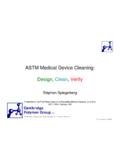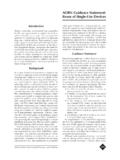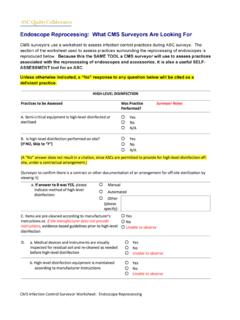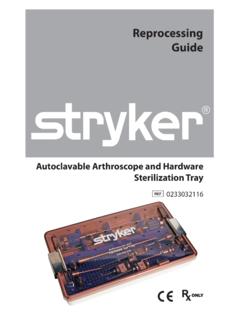Transcription of Infection Prevention in Endoscopy - APIC Houston
1 Infection PreventioninEndoscopy, Keeping Patients and Practioners SafeCheri Ackert-Burr, RN, MSN, CNORC linical Education Manager, MedivatorsAugust 11, completion: Participants must complete the entire program and submit required of interest: Planners disclose no conflict; the speaker discloses employment with Medivators, thereby declaring a conflict of company support: Fees are underwritten by education funding provided by Medivators. therapy: None Disclosures Review Guidelines related to Infection Prevention Discuss chemistries used in the cleaning and high level disinfection Discuss recent events related to Infection Control and Prevention in Endoscopy Present alternative solutions for preventing Infection transmission related to reprocessing endoscopes and accessoriesObjectivesSociety Food and Drug AdministrationProtecting and Promoting YourHealth Why they are important Provides evidence based practice to support the rationale for the actions Provide a system to have standardized care delivered to patients Developed and researched by key opinion leaders, physicians, nurses, and professional organization officersGuidelinesGuidelinesGuidelinesMi croorganisms on our Person1 sq in1 sq cm1 gram = 1/5 teaspoon or.
2 035 ozSources of ContaminationThe Bug Stops Here Bedside precleaning Contained transportation Cleaning and decontamination Drying StorageChain of Infection Grows anywhere there is a fluidpathway Most prevalent organism transmitted Number one HAI identifiedPseudomonas AeruginosaGram stain positiveAgar plate growth MRSA Methicillin resistant staphylococcus aureus VRE Vancomycin resistant enterococcus CRE Carbapenem-resistant Enterobacteriaceae Clostridium DifficileMultidrug Resistant OrganismsSterilizationHigh Level DisinfectionIntermediate DisinfectionLow Level DisinfectionBacterial SporesGeobacillus stearothermophilusBacillus subtilisBacillus atrophaeusClostridium sporogenesCyst forms of parasitesCryptosporidium oocystsMycobacteriaMycobacterium tuberculosis var. bovisNontuberculous mycobacteriaMycobacteriaMycobacterium tuberculosis var.
3 BovisNontuberculous mycobacteriaNonlipid or small virusesPoliovirusCoxsackie virusRhinovirusNonlipid or small virusesPoliovirusCoxsackie virusRhinovirusNonlipid or small virusesPoliovirusCoxsackie virusRhinovirusFungiTrichophyton forms of parasitesNon-cyst forms of parasitesNon-cyst forms of parasitesVegetative bacteriaPseudomonas aeruginosaStaphylococcus aureusSalmonella choleraesuisEnterococciVegetative bacteriaPseudomonas aeruginosaStaphylococcus aureusSalmonella choleraesuisEnterococciVegetative bacteriaPseudomonas aeruginosaStaphylococcus aureusSalmonella choleraesuisEnterococciVegetative bacteriaPseudomonas aeruginosaStaphylococcus aureusSalmonella choleraesuisEnterococciLipid or medium-sized virusesHerpes simplex virusCytomegalovirusRespiratory syncytial virusHepatitis B virusHepatitis C virusHuman immunodeficiency virusLipid or medium-sized virusesHerpes simplex virusCytomegalovirusRespiratory syncytial virusHepatitis B virusHepatitis C virusHuman immunodeficiency virusLipid or medium-sized virusesHerpes simplex virusCytomegalovirusRespiratory syncytial virusHepatitis B virusHepatitis C virusHuman immunodeficiency virusLipid or medium-sized virusesHerpes simplex virusCytomegalovirusRespiratory syncytial virusHepatitis B virusHepatitis C virusHuman immunodeficiency virusPrions, the causative agents of transmissible spongiform encephalopathies, present a unique resistance challenge to germicidal chemicals.
4 Prions have been shown to have unusually high resistance to heat and chemicals, in some cases demonstrating greater resistance than bacterial spores. In suspected or confirmed cases, special consideration should be given to prion decontamination. See AORN recommendations regarding processing of prions Work flow dirty to clean Pt room Transport away from trafficareas Decontamination Physically separated reprocessing StorageEndoscopy Workflow PatternCycle of an Endoscope -TraceabilityProcedure & Bedside CleaningLeak TestingManual CleaningHigh-level DisinfectionStorageFDA Problem child for reprocessingWhy it needs to be side viewing with elevator lifts Over a half million patients each year are treated using duodenoscopes CRE emerged in 2012 at hospitals in Seattle, Pittsburgh and Chicago. Most recently again in Seattle Many doctors who use the scopes and most patients don t know the risks It is resistant to last defense antibiotics.
5 It kills up to 40% of the people it infects infections may go unnoticed because patients have other health problems (None of the 7 deaths in Seattle were solely from CRE) Culturing is challenging and must specific guidelines Multidrug resistant organisms such as VRE, MRSA, C. diff and CRE are all serious concerns in endoscope reprocessingWhat is CRE and why is killing this Super Bug so important?Sales Support Documents Duodenoscope reprocessing guidelines reviewed several times a year Cleaning should occur in the open and closed position Consider inspecting with a magnifying glass Must be thoroughly dried before storage Bridge mechanism meticulously cleaned during the manual cleaning process Leave the bridge mechanism at a half raised position for reprocessingInterim Duodenoscope Surveillance ProtocolInterim Protocol for Healthcare Facilities Regarding Surveillance for Bacterial Contamination of Duodenoscopes after : January 23, 2013 RE: Elevator/Raiser Wire Bridge Position during ReprocessingProduct Support DocumentsProduct Bulletin: Carbapenem-resistant Enterobacteriaceae (CRE) 50098-443 RvARapicide PARapicide OPA 28 Product Bulletin.
6 Carbapenem-resistant Enterobacteriaceae (CRE) 50098-443 Bulletin: Carbapenem-resistant Enterobacteriaceae (CRE) 50098-443- Bulletin: 510 (k) Clearances for Medivators Endoscope (k) Clearances for AERs Detergents Enzymatics Non enzymatic -biofilm detaching agents Disinfectants Glutaraldehyde Ortho-ophtalaldehyde Peracetic acid Hydrogen peroxide 70% Ethyl or isopropyl alcoholCombating Infection Thru ChemistryEnzymatics Reduce cohesive forces and act like scissors to break up soil Substrate specific only breakdown what they are attracted to Types of enzymes (substrates) Protease proteins (blood, mucus, body fluids) Amylase -carbohydrates Lipase -fats Each cleaning cycle uses up the enzymes for each scope get clean detergent solution for each scope, Do Not ReuseDetergentsBiofilm Detaching Agent Detergent Biofilm can form wherever a surface is exposed to a fluid pathway Enzymes are unable to react with biofilm EPS matrix6 day growth of a P Aeruginosa biofilmBiofilm treated with a bio-film detaching detergent Micro-organisms surrounded by the slime they produce Exists wherever surfaces contact water Bacteria live in biofilm communities Interferes with disinfection All surfaces easily colonized Difficult to remove Physical propertiesBiofilmBiofilm GrowthDetergentTypes Non-enzymatic detergents Acts by reducing chemical bonding between soil and endoscope surface Penetrates through biofilm to reach the surface of the endoscope Enzymatic detergents Act by reducing cohesive force within soil itself Digests the outer shell of biofilm Formulations
7 Consist of one or more substrate specific enzymes Clean solution for each scope Do Not Reuse Correct concentration per IFU (instructions for use) Correct contact time each detergent is different Correct temperature some detergents require heated waterDetergents RecipeBiofilm RevealedCleaning AccessoriesButtons and ValvesAir / Water ValvesSuction ValvesButton and Valve ResearchParente. D. M. (2009). Could biopsy port valves be a source for potential flexible endoscope contamination? EndoNurse. Retrieved from: scopesCost of Leaks Minor -$200-500 Air/water blockage Angulation adjustment Bending rubber replacement O ring replacement Semi-Major $500-$2500 Replacement of Channel replacement Insertion tube Bending section replacement CCD Major Repairs -$2500 + Insertion tube and contents Severe light-guide Image guide damage Complete scope overhaul Fluid invasionHigh Level Disinfection: A lethal process utilizing a sterilant under less than sterilizing conditions.
8 The process kills all forms of microbial life except for large numbers of bacterial Level Disinfection All are considered high level disinfectants All must be able to kill most endospores but not all All must be able to kill mycobacterium tuberculosis All have specific instructions for use unique to the chemistry All have dedicated test strips for the specific chemistry being usedDisinfectants Cleared by the FDA Aldehydes inactivate microbial proteins by crosslinking the functional groups in the proteins Glutaraldehyde Ortho-ophthalaldehyde Oxidizing agents kill microorganisms by releasing large amounts of oxygen, which contributes to the alteration of microbial enzymes Hydrogen peroxide Peracetic acidHow Disinfectants Kill Aldehydes Ortho-ophthalaldehyde Hydrogen peroxide Peracetic acidHigh Level Disinfectant CategoriesDisinfectants -GlutaraldehydeAdvantages Proven efficacy Good materials compatibility Reusable Can be used in AERs or for manual high level disinfectionDisadvantages Can cause skin.
9 Eye or respiratory sensitization Must regulate vapor exposure Can act as a fixative if there is residual bioburden on or in the scopeOPA Ortho-ophthalaldehydeAdvantages Fast acting Excellent materials compatibility Does not coagulate blood or fix tissues to scope surface Odor not significant Can have a 28 day use life not all do Disadvantages Stains protein gray More expensive Can not be used for GU procedures bladder cancer patients have a higher sensitivity to this chemical May have only a 14 day use lifePeracetic Acid & Hydrogen Peroxide -PAAA dvantages No activation Odor not significant Irritation not significant Works well with biofilm detaching agent Does not fix protein to scope surface More tolerant of organic matterDisadvantages Minor compatibility issues (copper, brass, lead, zinc) Potential skin and eye irritantHydrogen PeroxideAdvantages No activation May enhance removal of organic material No odor or respiratory irritation Does not coagulate or fix tissue to scopeDisadvantages Compatibility issues with some medical devices Cosmetic changes Serious eye damage if contact is madeDisinfectantConcentrationContact TimeTemperatureRinses RequiredUser LifeDays or min45 min90 min35 C25 C25 C3 rinses3 rinses28 days/MEC28 min5 min20 C room temp25 C3 rinses2 rinses14 days/MEC14 days/MEC28 days/MEC28 days/MECH ydrogen Peroxide2% min30 min20 C room temp or AER25 C1 rinse1 rinse21 days21 daysPeraceticAcid1000-1300 ppm /AER1820 ppm/AER5 min6 min30 C46-55 C1 rinse2 rinses21 days/MECS ingle use cupsTake Away for High Level Disinfectants Each chemistry has a manufacturer
10 S Instruction for Use follow it Not all chemistries are created equal know their characteristics and how they work Chemistries work when used correctly they just work in different ways Hats/hair cover Goggles/face shields Gowns Gloves Shoe/covers Noise protection VestsPPE Air exchanges 10 to 12 per hour Access Control access Traffic patterns Restricted access Semi-restricted access Non-restricted accessProtecting the Environment & PatientAlternatives for Infection PreventionOld practice reprocessing all parts Many steps and time involvedNew practice Disposable Disposable air/water valves Disposable suction valves Disposable biopsy valves 24 hour use water bottles and tubing Disposable brushes Disposable cleaning devices Disposable procedure kitsAlternatives in Infection PreventionConsiderations for Choosing Disposable vs ReusableHard Costs Cost per device used How long do they last How are they tracked Inventory needed Hourly wage of person doing the cleaning Setup and tear down time between procedures Room unable to be usedSoft Costs Time for each cleaning step Sterilization or reprocessing time Packaging requirements Storage Training of staff Outcomes measurement Infection Prevention is a major concern in Endoscopy infections can happen at many levels reprocessing correctl





